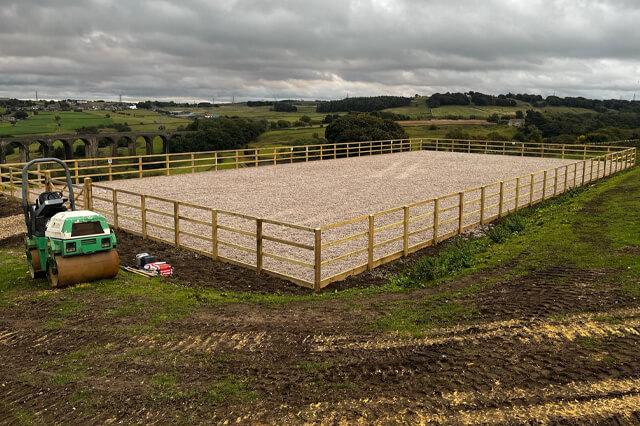The Specialist in Constructing Equestrian Riding Arenas
A.J. Atkins are specialists in building equestrian arenas from both outdoor or indoor spaces specifically designed for riding and training. We construct arenas that are safe and comfortable for both the horse and rider, and they must be able to withstand the wear and tear of regular use.
A.J. Atkins are experts in a variety of areas, including engineering, design, landscaping, and construction. We can also work with architects and engineers to create a custom design that meets the needs of our clients, or they may have pre-designed plans that can be adapted to the specific requirements of the project.
Key considerations
There are many key considerations to take when building equestrian arenas. As specialists in this field we have a thorough understanding of these factors and can work closely with the client to ensure that the final product meets their needs and expectations.
1. Location: The location of the arena should be in a relatively flat area with good drainage and access to utilities such as water and electricity. The location should also be free from hazards such as rocks, trees, or uneven terrain that could pose a risk to horses and riders.
2. Size: The size of the arena will depend on the intended use, but as a general rule, a dressage arena should be at least 60ft x 120ft, while a jumping arena should be at least 80ft x 150ft. The size should allow for comfortable movement and space for riders and horses.
3. Footing: The footing of the arena is critical for the safety and well-being of the horses and riders. There are several types of footing available, including sand, rubber, and mixed materials. The footing should be designed to provide good traction and cushioning for the horses' hooves, absorb shock, and prevent slipping.
4. Drainage: Proper drainage is essential to prevent standing water, which can be a breeding ground for bacteria and parasites, and can also cause damage to the footing. A well-designed drainage system should be installed to ensure water is properly diverted away from the arena.
5. Lighting: Adequate lighting is necessary for riding in the early morning or evening. The lighting should be evenly distributed and provide sufficient brightness without causing glare.
6. Fencing: Fencing should be installed around the perimeter of the arena to prevent horses from running out of the area. The fencing material should be sturdy, safe, and horse-proof.
7. Jumps and obstacles: If the arena is intended for jumping, jumps and obstacles should be placed in strategic locations to challenge riders and horses. The jumps should be sturdy, safe, and properly designed.
8. Maintenance: A maintenance plan should be developed and followed to ensure the arena remains in good condition. This should include regular grooming of the footing, repairs to fencing or jumps, and upkeep of the drainage system.
These are just some of the specific requirements to consider when building an equestrian riding arena. It's important to work with experienced professionals who can provide guidance on the best practices and ensure that the final product meets your specific needs and requirements.
Recent Arena Projects

Bradshaw Equestrian Arena
Create a 40m x 20m riding arena on a sloped site with extensive groundworks and the removal of over 2500 Tons of earth.
SEE More
Illingworth Equestrian Arena
60m x 20m Arena construction on a tight site, close proximity to dwellings and the footings and services for the adjoining stable block.
SEE More
Cullingworth Arena
Creating a remarkable Equestrian Arena in this picturesque location with breathtaking views was enjoyable and crucial.
SEE More